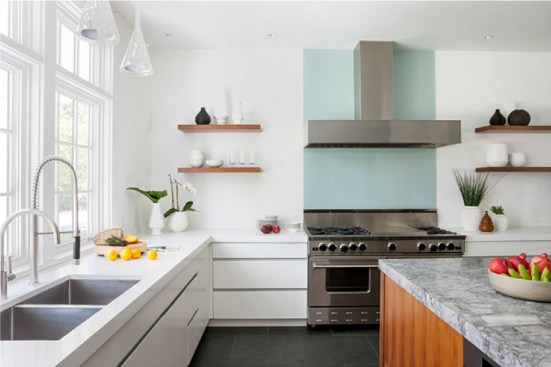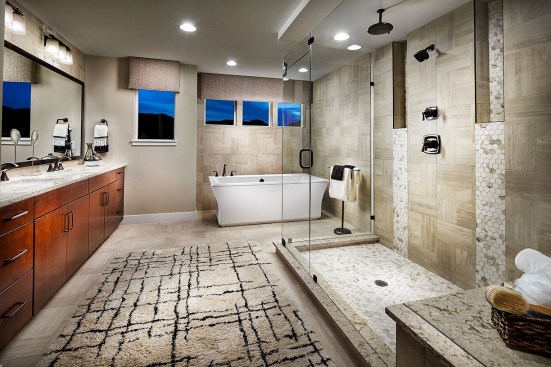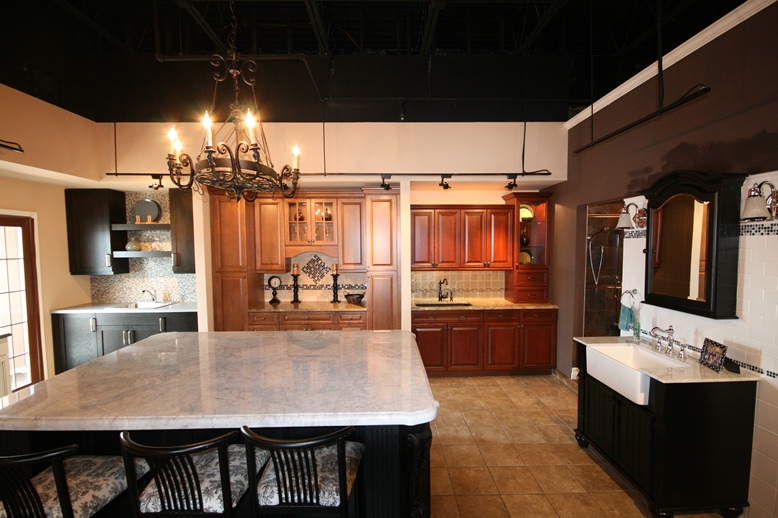When homeowners choose Long Island, N.Y.-based Alure Home Improvements for a remodel, they are invited to the company’s 8,000-square-foot showroom in East Meadow, where they can walk through full-size, working kitchens, bathrooms, basements and sunrooms; learn about insulation and modular construction; choose colors, styles, materials and finishes; watch their kitchens be transformed on a state-of-the-art design imaging system; and see their future bathroom in three dimensions. It’s a design Disneyland, with associates on hand to tease out the homeowners’ wants, needs and pain points while educating them about their options.
“We show them all the different options—good/better/best—and tell them why,” says custom kitchen and bath sales and design manager Gina Bonura. “We don’t upsell, because we’re building a relationship. We’re fulfilling clients’ needs with products and services, and that’s the best way to ‘upsell.’ It’s all about educating customers to upsell themselves, and they absolutely will. But the days of the hard sell are gone.”
For John Day, principal and director of interior design at Cambridge, Mass.-based LDa Architecture and Interiors, that means asking a lot of questions and getting to the core of what people appreciate and value, where they want to make bold design statements, and whether they’re choosing items because they perform well or bring them joy. It’s important to Day that his clients have enough information to make good choices so they don’t feel like their remodel got out of hand. “Even our most budget-unconscious clients want to feel like they’re getting good value,” he says.
Rochester, N.Y., developer and home builder Riedman puts considerable resources into offering the most current designs and staying ahead of the trends at its design center in Victor, N.Y., for this reason, and president David Riedman says it pays off. Buyers are making more “additional investments” (the PC term for spending more money), he says, and the design center differentiates Riedman from competitors. Home buyers “walk away from the experience with the home they want as opposed to feeling like they were sold as much cabinetry as possible.”
Upserving, Not Upselling
Times have changed since McDonald’s chairman Ray Kroc introduced upselling to the masses by asking customers if they wanted fries with their sandwiches. Kroc knew that people buy more when they’re already in buying mode, and his directive nearly doubled fries sales. However, consumers today are warier and better informed than they were in the 20th century.
“People don’t want to be sold—they want to be educated,” says Suzanne Felber, founder of Lifestylist Brands, a home-design information resource and consultancy. “When they trust you, they will buy from you.” Sales centers need to become educational tools instead of sales tools, Felber says, and builders need to inform buyers about the choices they’re making if they want to avoid warranty issues. When homeowners don’t know how to take care of granite, for example, “everybody loses.”
Jane Meagher, president of Success Strategies, a consulting firm that has helped builders in more than 120 markets create strategic design studios and trained thousands of design studio associates, calls the process of informing and education home buyers upserving.
“When you upsell, you’re focused on driving more revenue at any cost,” she says. “When you upserve, you educate customers about higher-value products, and if they see the value and decide to invest, they end up with homes more closely aligned with their wants and needs, reflecting their unique personalities.”
At national home builder Toll Brothers’ 25 design centers throughout the country, associates take “a very distilled, custom approach for every customer,” says chief marketing officer Kira Sterling, getting to know home buyers’ lifestyles and how they intend to live in their homes so they can tailor presentations and offerings to the buyers’ needs. Design center staff members are reminded to guard against preconceived notions based on factors like generation and gender, because “everyone is a unique individual,” Sterling says.
Alexa Drees, senior design consultant at Jacksonville, Fla.-based Drees Homes, begins building relationships with home buyers when she greets them at their first design center appointment with a chalkboard at the front door that says, “Welcome home, Mr. and Mrs. Smith.”
Educated, Design-Savvy Clients
Remodeling a house can be a scary prospect. Homeowners worry about whether their colors will work or if their tiles will go out of style. Today, though, many of them have access to digital resources like Houzz and Pinterest, and they’re more design-savvy than ever before.
“People are asking for things that are high-end that they wouldn’t have asked for before,” Bonura says. “They see it, and now they want it. So they’re walking in upselling themselves before we even get to them.”
The downside to this, says Drees, is that her clients generally have no idea how much the pretty things they see on TV cost, and they’re disappointed when they can’t squeeze $80,000 worth of upgrades into a $10,000 budget. “Achieving those looks for less has definitely been a challenge for all design centers to overcome,” she says.

Greg Premru Photography
Increased exposure to design media has elevated many clients' tastes, as reflected in this remodel by LDa
Day says clients’ Pinterest boards are helpful because he and his staff can spot trends in the clients’ preferences, but they should be conversation starters only. If customers come in with a hard-and-fast idea about what they want based on media and social media, he says, he’ll engage them in a deeper conversation about how they plan to use their houses.
Clients also need to understand, Day says, that the houses they see on HGTV and Houzz didn’t just pop up overnight. “We live in a digital world, but building is still an Old World process,” he says. “I think that’s the hardest learning curve. It doesn’t come together like it does on TV, and it typically costs more than they expect.”
Chris Landis, AIA, co-owner of Washington, D.C.-based renovation and remodeling firm Landis Architects/Builders, says his clients often find the look they want on Houzz but haven’t focused on actual products. He uses 3D software to help them see colors, textures, perspectives, and elevations. Software called Builder Trend keeps all their choices in a cloud portal so they can visit any time and share with friends and family. It’s great for clients who travel, Landis says, “and it’s always there so they can go back and revisit their decisions.”
National home builder Meritage recently began offering Envision, an online application that lets home buyers see and research many of their options as they prepare for their design center appointments, to all its new customers last year. Sacramento, Calif.-based BlackPine Communities also uses the Envision portal to make selecting products more comfortable and fun, says founder, president and chief financial officer Michael E. Paris. He has seen that “the more prepared folks are and the more ability they have to see and feel things in our design center, the more exponentially their tendency to spend, so to speak, increases.”
They Deserve It
For the most part, today’s buyers are pretty certain they deserve outdoor fireplaces, connected-system coffeemakers, and prestigious stoves with recognizable knobs. Offering those products gives remodelers a leg up in the marketplace. A recent survey of potential home buyers commissioned by gas grill and fireplace company Napoleon found that 52% of potential homeowners had a more positive impression of builders that offer upgrades.
“We learned from the Hot Spots Research Study that success isn’t just about upselling products but more about designing spaces and incorporating amenities that increase the emotional appeal of a room,” says Stephen Schroeter, Napoleon’s senior vice president of sales.

KGA Studio Architects/Eric Lucero Photography
This model by Epic Homes shows off the contemporary styles today's consumers want
Jerry Gloss, a senior partner at Louisville, Colo.-based architectural firm KGA Studio Architects, says more clients are asking for things like wine rooms, drop zones, and professional kitchens, which he calls “I-deserve-it features.” Baby boomers are especially ripe for upselling, Gloss says, as long as no one uses that term. “Boomers don’t want to be sold to, but they’re tired of settling. They figure they’ve worked their whole life for this house, and with lower interest rates, their dollar goes a little bit further.”
Remodelers and builders are wise to target affluent empty nesters who are often trading down in square footage, have discretionary dollars, and “feel like it’s their time to shine,” Meagher says. But she points out that millennials tend to feel no less entitled to superior products than their boomer parents.
Raised in a world full of hyper-segmented choices, millennials don’t want to live in a box that looks like the neighbors’ house, Felber says, and they expect the latest technology. “Toilets, for example, are probably the most unsexy thing we could talk about, but with water issues today, the technology is changing. Millennials are sensitive about the environment, and they’re not going to settle for a standard toilet anymore.”
Builders Design regional vice president Lesley McCarthy says curation is key to reaching all these buyers, who feel an immediate sense of trust when design centers feature trend-forward products they’ve seen on Houzz and HGTV. Design centers stocked with tired, old products and fixtures lose sales, says Mary DeWalt, president of DeWalt Design Group, an Austin, Texas-based model home merchandiser, because buyers in every segment of the market are constantly exposed to aesthetically and functionally superior products. “It’s important,” she says, “to have opportunities for buyers to make themselves happy and also add to your bottom line.”
“As buyers invest more money into their homes, there is and should be a direct correlation to their increased satisfaction with the house they create,” Meagher says. “We shouldn’t have any guilt around making money as long as we’re serving customers with integrity and making sure they’re thrilled and delighted.”
